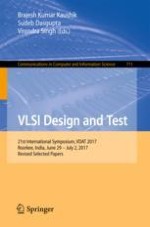2017 | Buch
VLSI Design and Test
21st International Symposium, VDAT 2017, Roorkee, India, June 29 – July 2, 2017, Revised Selected Papers
herausgegeben von: Brajesh Kumar Kaushik, Sudeb Dasgupta, Virendra Singh
Verlag: Springer Singapore
Buchreihe : Communications in Computer and Information Science
